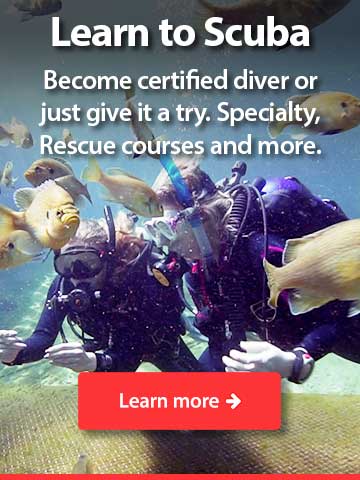Advanced Nitrox/Deco Procedures

Both cave and technical diving invariably involve decompression. There is more to decompression, however, than simply doing what your dive computer says.
- You must understand which gas or gas mixtures provide the optimum decompression for any situation.
- You must be able to predict your decompression schedule then determine how much deco gas you will need.
- You must understand the risks involved with using pure oxygen or gas mixtures with high oxygen concentrations.
- You must be able to correctly set up, label and use decompression cylinders.
The best decompression training combines two distinct disciplines:
- The first is using breathing mixtures with high O2 concentrations.
- The second is making decompression dives.
This is why most divers take a two-course combination — Advanced Nitrox plus Deco Procedures — to get their decompression training. We offer this. You can do these courses together as a standalone program. Or you can combine them with your full Cave Diver training.
Who Can Take This Course?
Exact prerequisites vary by agency but, in general, you:
- Must be at least 18 years old.
- Have logged at least 25 dives.
- Should possess a minimum of entry-level Nitrox Diver and Advanced Open Water certification or equivalent.
- Either be able to answer No to all the questions on an industry-standard Medical History form or obtain a physician’s approval for diving before the start of the course. If you require a physician’s approval, the doctor must sign off on the standard Medical Exam form. Forms signed no more than twelve months before the start of the course are acceptable — provided you have had no change in medical history since then.
If you intend to take the course in north-central Florida, you must also be a fully certified cave diver. This is because the only sites possessing sufficient depth are inside caves.
What is Involved?
This course typically consists of:
- Self-study.
- At least six training dives and 150 minutes of Actual Bottom Time. You can do this concurrently with full Cave Diver training, if need be.
Where Does the Course Take Place?
Assuming they already possess Cave Diver certification, most of our students do their training in north-central Florida’s freshwater springs and caves — however, you are by no means limited to this. We regularly conduct courses in Russia’s famous Orda system, the world’s largest underwater gypsum cave, as well as do training in Mexico’s cenotes. The choice is up to you.
How Much Does it Cost?
The exact cost of this program will depend on a variety of factors, such are:
- Will you be taking this course by yourself or with one or two other friends or family members?
- Are there any prerequisite courses you need to take in conjunction with the course which will result in your desired certification?
- Where will you be taking the course? (Courses conducted in north-central Florida generally have the lowest cost.)
Once we determine your specific needs, we can give you a firm price for all the required training. Bear in mind, the course fees generally cover just the cost of instruction. You are responsible for:
- Transportation to and from the course location and dive sites.
- Any overnight accommodations and meals.
- Supplying the required equipment and gas fills.
If you want certification cards from multiple agencies, you will need to pay the associated card processing fees. Keep in mind organizations such as TDI and IANTD will require you purchase their specific textbook or eLearning materials, in addition to any materials supplied with the course.
What Equipment Will You Need?
The minimum equipment requirements for most courses include:
- Mask and adjustable fins.
- Backup mask.
- Adequate exposure protection for the environment.
- Either back-mounted doubles or sidemount cylinders.
- Either a backplate/harness for backmount or an appropriate sidemount harness/air cell with adequate lift capacity.
- Deco bottle and regulator.
- Two separate high-performance regulators.
- One primary and two backup lights.
- One primary reel/spool plus one backup per diver.
- Two cutting tools per diver.
- Two depth gauge/timers or two mission-capable dive computers per diver.
Some very specific requirements pertain to each items. Do not make any equipment purchases without first speaking to your instructor.
Note: if you will be traveling by air to the course site, we can help you to arrange the rental of heavier items such as tanks at your destination.
How Do You Sign Up?
The best way to get started is to simply contact us.

